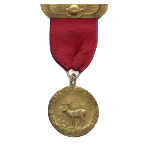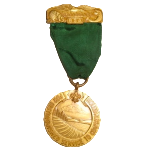William T Hornaday was a zoologist and conservationist who had a dramatic influence on the Scouting program’s emphasis on conservation and preservation of our environment and wildlife. He started a fund in 1913 called the Permanent Wildlife Protection Fund, abbreviated as PWLPF, that was to be endowed with $100,000 and used to promote wild life conservation.
In 1914, Dr. Hornaday contacts the BSA and offered to create an award for Scouts who do “distinguighed service” towards conservation. His proposal provides that the BSA can select the medal’s winners, but that they must be approved by the Trustees of the P.W.L.P.F. Starting in 1917 the Permanent Wild Life Protection Fund awards its first medals, none of which are awarded to Scouts.
In 1922, the first Scout to earn the PWLPF medal was Harry Hall, who was a Scoutmaster in Pennsylvania, only four other BSA members were awarded a Permanent Wild Life Protection fund medal, though as many as 25 were awarded in some years, so there are a number of them in existence, though only 5 are documented as being awarded to BSA members. The P.W.L.P.F. badge has an egyptian style emblem of spread wings with snake heads sprouting from a sun. The front reads “FOR SERVICES TO WILD LIFE”, and the back is engraved “AWARDED BY PERMANENT WILD LIFE PROTECTION FUND TO ” and the recipients name.
In 1937 Dr. Hornaday passes away and afterwards the awards program is revamped and renamed to the Hornaday Awards. Between 1941 and 1950, 5 Type I Hornaday Medals are awarded to BSA members, the award is comprised of the original PWLPF badge design which holds a red ribbon and a medallion with a deer on it. The front reads “DISTINGUISHED SERVICES TO WILDLIFE” and “P.W.L.P.F.” at the bottom of the medallion, some later medals did not have the PWLPF at the bottom. The back is engraved “THE HORNADAY AWARD PRESENTED BY BOY SCOUTS OF AMERICA TO ” followed by the recipient’s name and the date.
In 1952 the new Type II Hornaday Award is introduced with a new badge which features a beaver, duck and fish, it has a green ribbon that holds a medallion with an image of a nature scene. The front reads “FOR DISTINGUISHED SERVICE TO CONSERVATION”, and usually has the recipient’s name engraved on the back.
According to the BSA’s website over 1,100 Hornaday Awards have been earned by Scouts in the past 80 years.
They can still be earned today by any Boy Scout, Varsity Scout, or Venture Scout who completes a set of merit badge requirements related to the environment and conservation and carries out an approved conservation project. This badge is completed at the Council level. A Scout can also earn the national level Bronze or Silver Medal by completing additional merit badges and conservation projects.
Adult Scouts can be awarded the Gold Badge on the Council level and the Gold Medal on the National level, the adult award is earned through a nomination process so they cannot earn the award simply by completing a series of requirements. The adult Gold badge is awarded for service at the Council or District level over at least 3 years. The Gold Medal must be earned by service at the National or Regional level over at least 20 years, this award is very difficult to earn and clearly shows a devotion and dedication to conservation, additionally only six awards can be given in a year.
Hornaday Awards their predecessor award from the Permanent Wildlife Protection Fund are all rare and desirable to collectors, the Type II is much more common than the older awards, but is still desirable to collectors.
Click the thumbnails for a larger image





